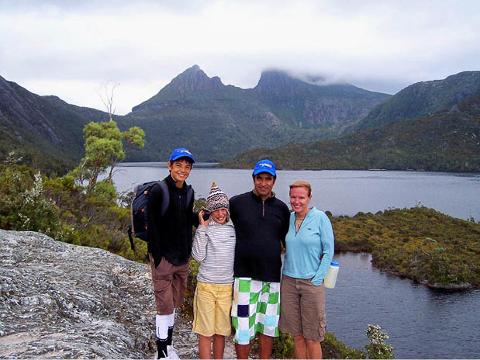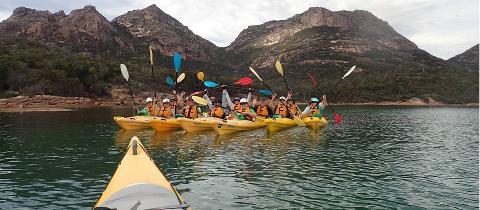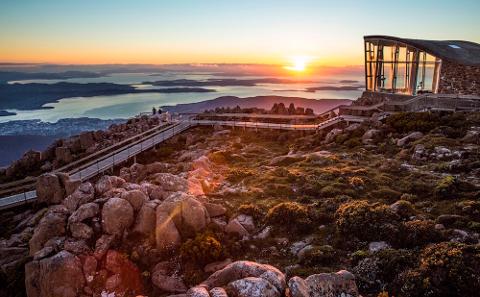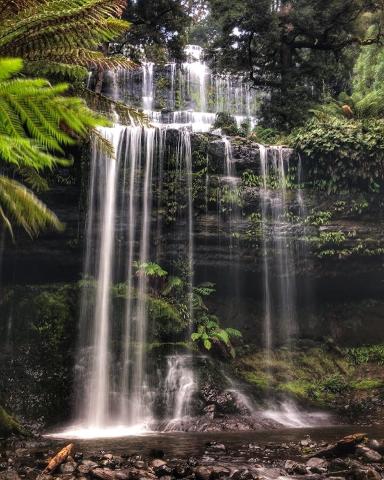 Join us as we delve into the captivating world of the nocturnal scavenger known as the Tasmanian Devil. Let's unravel their distinct behaviours, and explore how conservation efforts strive to protect this Endangered species from habitat loss, protection from the introduction of invasive species, and disease.
Join us as we delve into the captivating world of the nocturnal scavenger known as the Tasmanian Devil. Let's unravel their distinct behaviours, and explore how conservation efforts strive to protect this Endangered species from habitat loss, protection from the introduction of invasive species, and disease.
The Tasmanian devil (Sarcophilus harrisii) is one of the largest carnivorous marsupial characterised by its stocky build, black fur, pungent odour, and loud screech. It has one of the most powerful bites per unit body mass among predatory land mammals. Unfortunately, its population has been drastically reduced due to a tumour disease (DFTD), leading to its listing as endangered in 2008. Efforts are being made through initiatives like the Save the Tasmanian Devil Programme to protect and preserve this iconic animal.
 Let's start with their appearance: They are known for their stocky and muscular build. Their stout bodies covered in thick black fur help them maintain heat in their cool habitat. Their short legs and powerful claws allow them to move swiftly on the ground, while their bushy tail assists with balance during rapid movements. One notable characteristic is their pungent odour, a defense mechanism against potential predators.
Let's start with their appearance: They are known for their stocky and muscular build. Their stout bodies covered in thick black fur help them maintain heat in their cool habitat. Their short legs and powerful claws allow them to move swiftly on the ground, while their bushy tail assists with balance during rapid movements. One notable characteristic is their pungent odour, a defense mechanism against potential predators.
In terms of behaviour, they possess a loud screech that can be pretty startling. This vocalisation is vital in communication between individuals - from marking territory to expressing aggression or mating readiness. Additionally, they have a strong sense of smell that aids in locating prey, carrion, or rivals.
To further understand their characteristics, let's explore some key aspects:
| Characteristic | Description |
|---|---|
| Biting Force | One of the strongest bites among predatory land mammals. Their bite force is essential for feeding. |
| Diurnal Activity | Unlike many nocturnal animals, they're active without overheating during the middle of the day. |
| Climbing and Swimming Ability | These marsupials can climb trees and swim across rivers, showcasing their versatility in various habitats including: Coastal scrublands, Forests, Grasslands, Mountains, Rivers, and Caves. |
| Mating Behaviour | Devils are not monogamous, and as part of their Social structures, males engage in fierce fights to secure mating rights with females during the breeding season. |
| Reproductive Patterns | Females have a unique reproductive cycle where they can ovulate three times in as many weeks, increasing their chances of successful breeding. |
| Parental Care | After birth, the newborn devils, called joeys, are pink and weigh around 0.20 g. They fiercely compete for access to only four available nipples inside the mother's pouch. |
These general characteristics vividly depict what makes these animals such intriguing creatures. Now, let's delve into their fascinating carnivorous predatory behaviour.
They exhibit aggressive behaviour as predatory carnivores, showcasing their prowess as wild hunters. Their diet primarily consists of carrion (dead animals), making them an essential part of the ecosystem's waste disposal system.
When hunting live prey, they display remarkable ferocity and determination. They target small to medium-sized animals like rodents, birds, reptiles, and, when necessary, even larger prey such as wallabies or possums. Their strong jaws and sharp teeth allow them to despatch their victims with a powerful bite quickly.
Imagine witnessing a Tasmanian devil stealthily stalking its prey through the dense undergrowth of Tasmania's forests before launching into a swift attack, utilising its muscular body and sharp senses to secure a meal.
Despite being predominantly solitary animals, multiple devils may gather at a carcass site, resulting in raucous feeding frenzies with loud growls, snarls, and screeches filling the air. These intense feeding gatherings reflect their competitive nature, as each one vies for the best portion of the meal.
An interesting survival adaptation is their ability to consume bones and even fur along with the flesh of their prey. This skill aids in efficient digestion and ensures that no part of the carcass goes to waste.
It's important to note that while they are formidable hunters, Tasmanian devils also scavenge on carrion opportunistically. This behaviour enables them to capitalise on available food sources, ensuring their survival even in harsh environments or during times of scarcity.
The carnivorous predatory behaviour of Tasmanian devils highlights their critical role in maintaining ecological balance. Understanding their behaviour helps us appreciate this species' unique position within Australia's natural landscape.
- The takeaway from this information is that Tasmanian devils are skilled hunters and scavengers, playing a vital role in the ecosystem as predators and waste disposers. Their predatory behaviour includes targeting various types of live prey and exhibiting ferocity and determination during hunts. While primarily solitary, they can gather at carcass sites for intense feeding frenzies, showcasing their competitive nature. An exciting adaptation is their ability to consume bones, fur, and flesh, aiding in efficient digestion. Understanding their behaviour helps us appreciate their essential position in maintaining ecological balance in Australia's natural landscape.
 With its unique appearance, it is a captivating animal that stands out among Australia's wildlife. This carnivorous marsupial sports a stocky size and muscular build, covered in thick black fur that gives it a striking and unmistakable appearance. Its fur is excellent camouflage in Tasmania's dense forests and rocky landscapes, allowing it to blend into its natural surroundings. However, the Tasmanian devil possesses several other distinctive physical features beyond its striking fur.
With its unique appearance, it is a captivating animal that stands out among Australia's wildlife. This carnivorous marsupial sports a stocky size and muscular build, covered in thick black fur that gives it a striking and unmistakable appearance. Its fur is excellent camouflage in Tasmania's dense forests and rocky landscapes, allowing it to blend into its natural surroundings. However, the Tasmanian devil possesses several other distinctive physical features beyond its striking fur.
One notable feature of the Tasmanian devil is its pungent odour. This strong scent arises from scent glands on its rear end and plays a crucial role in communication between individuals. These glands produce a musky smell for marking space and identifying individuals within the population.
Regarding vocalisations, the Tasmanian devil is famous for its piercing and haunting screeches. These ear-piercing calls serve multiple purposes, such as establishing dominance, attracting mates during breeding, and communicating distress or aggression.
Perhaps one of the most remarkable physical attributes is its powerful jaw and bite strength. Their jaws can exert immense force when feeding on carrion or prey. This exceptional bite allows them to consume nearly every part of their prey, including bones and fur.
Despite their ferocity and strength, Tasmanian devils are known for their keen sense of smell. Their exceptional olfactory abilities help them locate food sources and communicate through scent marking over extended distances in their extensive home ranges.
- Since the late 1990s, a tumor ailment of the face named Devil Facial Tumour Disease (DFTD) has drastically reduced the population of Tasmanian devils and is part of the reason their Conservation status includes a recovery program.
- As reported by National Geographic in 2023, DFTD has led to an 80% decline in the wild population of these marsupials.
- Despite these challenges, conservation efforts, such as the Save The Tasmanian Devil Programme, have helped boost populations in captivity. According to a survey conducted by Save The Tasmanian Devil Programme in 2023, over 600 devils are now kept in over 100 facilities worldwide.

The Tasmanian devil is native to Tasmania, located off the southeastern coast of Australia. They have adapted to various habitats within this rugged and diverse environment, showcasing their resilience and survival skills.
Tasmanian devils are well-suited for life in diverse landscapes, including forests, woodlands, grasslands, and coastal areas. They possess excellent climbing abilities, allowing them to ascend trees for food or safety when needed. Additionally, their solid limbs and muscular bodies enable them to swim across rivers and streams, providing them with opportunities for exploration and expanding their territories.
While their habitat ranges across various landscapes, Tasmanian devils mainly thrive in densely forested areas where they can find ample food sources such as small mammals, birds, reptiles, and carrion. The thick vegetation provides cover from predators and allows them to move stealthily through the undergrowth.
In terms of adaptations, one notable attribute is their ability to regulate body temperature. Unlike other marsupials that are primarily nocturnal, Tasmanian devils are crepuscular animals that are most active during the middle of the day. This unique behaviour enables them to take advantage of daylight hours without overheating or competing with other nocturnal species for resources.
Furthermore, Tasmanian devils exhibit solitary behaviours while maintaining overlapping home ranges with other individuals. This allows them to avoid excessive resource competition while engaging in social interactions during the breeding season or encounters with potential mates.
For example, during mating season, males engage in fierce battles to establish dominance and secure breeding rights with females. This competitive nature ensures the most vital individuals pass on their genes while contributing to the genetic diversity within the population.
By adapting to different habitats and developing specific behavioural patterns, the Tasmanian devil has established itself as a resilient species capable of navigating its ever-changing environment.
 The Tasmanian devil, known for its unique and intriguing characteristics, calls Tasmania's diverse coastal and intertidal environments home. These environments play a crucial role in the survival and well-being of this fascinating species. The devils are adept at navigating through various coastal habitats, including rocky shores, sandy beaches, estuaries, and mangroves. They have adapted to living near the water's edge, where they can enjoy abundant food and shelter in rocky crevices or caves.
The Tasmanian devil, known for its unique and intriguing characteristics, calls Tasmania's diverse coastal and intertidal environments home. These environments play a crucial role in the survival and well-being of this fascinating species. The devils are adept at navigating through various coastal habitats, including rocky shores, sandy beaches, estuaries, and mangroves. They have adapted to living near the water's edge, where they can enjoy abundant food and shelter in rocky crevices or caves.
The coastal regions of Tasmania offer a rich and diverse ecosystem that provides the devils with a range of prey opportunities. The devils are opportunistic feeders, capable of consuming carrion,
small mammals, birds, reptiles, insects, and even marine life like seals or penguins. They exhibit remarkable adaptability by foraging along the shoreline during low tide to scavenge for crabs, shellfish, or stranded fish. Their presence in these intertidal zones highlights their ability to thrive in multiple habitats within their range.
Imagine walking along a picturesque Tasmanian beach during low tide. As you explore the rocky outcrops and tidal pools, you may encounter signs of the Tasmanian devil's presence – tracks
imprinted in the sand or remnants of their recent meals. Their resourcefulness allows them to exploit the bountiful food sources available in these coastal areas.
| Coastal & Intertidal Environments |
|---|
| - Rocky shores |
| - Sandy beaches |
| - Estuaries |
| - Mangroves |
These habitats provide food and are critical denning sites for breeding Tasmanian devils. The rocky crevices and burrows found along the coastline offer protection from harsh weather conditions
and potential predators. Within these dens, female devils give birth and raise their young, ensuring the species' survival. The coastal environments provide a unique set of challenges and advantages for the devils, contributing to their adaptability and resilience.
While the coastal and intertidal environments present opportunities for the Tasmanian devil's survival, they are also subject to various threats and challenges that must be considered.

The Tasmanian devil faces various threats and survival challenges in its struggle to maintain healthy populations. One of the most significant threats is (DFTD), which is covered in-depth in the following section. This aggressive and contagious cancer has had a devastating impact on the species over the past few decades.
Another major survival challenge Tasmanian devils face is habitat loss due to human development and land-use changes. As urban areas expand and agriculture intensifies, the devils' natural habitats become fragmented, making it challenging to find suitable food sources and mates. These changes can lead to increased competition among devils for limited resources, particularly in areas where their habitats intersect with human activities.
Additionally, climate change poses new threats to these remarkable creatures. Rising temperatures, altered rainfall patterns, and extreme weather events can disrupt ecosystems and impact prey availability. Habitat conditions can affect breeding success, hibernation cycles, and overall population dynamics.
In the face of these challenges, conservation efforts have been implemented to protect the Tasmanian devil and its habitats. Initiatives include captive breeding programmes, monitoring and research, habitat restoration projects, and public education campaigns. We can ensure this incredible species' continued survival through collective action and awareness.
One of the most critical threats to the Tasmanian Devil population is Devil Facial Tumour Disease, a contagious cancer that affects these unique marsupials. First discovered in 1996, DFTD has since become a significant concern for their survival. This transmissible cancer is spread via direct and indirect contact, often through biting during social interactions or feeding behaviours.
The tumours typically manifest around the mouth and head, leading to difficulty in eating and ultimately causing death due to starvation or secondary infections. This aggressive cancer has decimated devil populations across large areas of Tasmania. The rapid spread of DFTD results from genetic similarity among devils, which prevents an effective immune response and facilitates easy transmission.
Imagine a small group of devils residing in an isolated habitat. One member contracts DFTD, and their close-knit interactions lead to rapid transmission among the entire group. Within a short period, the population collapses, leaving behind a haunting silence that once echoed with their wild calls.
Efforts to combat this devastating cancer have been underway for many years.
The Save the Tasmanian Devil Programme (STDP) was established in 2003 as an official response to the threat of extinction faced by Tasmanian Devils. A collaboration between the Australian and Tasmanian governments, STDP's vision is to ensure an enduring and ecologically functional population of Tasmanian devils in the wild.
To achieve this goal, STDP focuses on several key conservation strategies:
- Research and Monitoring: To better understand DFTD and its impact on devil populations, extensive research is conducted. Monitoring efforts help track population trends, identify contagion hotspots, and evaluate management practices.
- Managing Condition Transmission: To prevent the spread of DFTD, initiatives are in place to identify and isolate diseased devils from healthy populations. This includes the establishment of insurance populations in infection-free areas, implementing biosecurity measures, and promoting responsible visitor behaviour.
- Breeding Programmes: Captive breeding programmes are crucial in maintaining genetic diversity and providing a safety net for devils. These programmes aim to enhance population resilience against DFTD by strategically pairing individuals with diverse genetic backgrounds.
- Community Engagement and Education: Raising awareness and fostering community support is vital in conserving this animal species. The STDP works collaboratively with communities, researchers, conservation organisations, and volunteers to promote understanding, citizen science initiatives, and involvement in devil conservation efforts.
- Long-term Management Strategies: It's essential to develop effective long-term management strategies considering disease control, habitat protection, predator control programmes, and sustainable land management practices that benefit both devils and their ecosystems.
The collective dedication towards saving Tasmanian Devils from the brink of extinction continues to drive these conservation efforts. However, challenges persist, and further research, funding, and public support are paramount to ensure a brighter future for this iconic species.
 Being a nocturnal scavengers, they are difficult to find in the wild. Therefore, the best place to view them up close is in one of the several animal parks in Tasmania listed below. Tasmanian Devil pictures thanks to Tourism Tasmania & Petra Harris.
Being a nocturnal scavengers, they are difficult to find in the wild. Therefore, the best place to view them up close is in one of the several animal parks in Tasmania listed below. Tasmanian Devil pictures thanks to Tourism Tasmania & Petra Harris.
Bonorong Wildlife Sanctuary - Brighton
| Pass | Cost |
|---|---|
| Family ( 2 adults, 2 children ) | $97 |
| Adult ( 16 years or older ) | $33.50 |
| Child ( 3-15 years old ) | $19.50 |
| Infant ( Under 3 years old ) | FREE |
Trowunna Wildlife Park – Mole Creek
| Pass | Cost |
|---|---|
| Family ( 2 adults, 2 children ) | $85 ( 12$ for every extra child ) |
| Adult | $30 |
| Child ( 3-15 years old ) | $18 |
| Seniors/Students ( i.d. required ) | $26 |
East Coast Natureworld – Bicheno
| Pass | Cost |
|---|---|
| Family ( 2 adults, 2 children ) | $89 |
| Family ( 2 adults, 3 children ) | $99 |
| Adult | $32 |
| Child ( 3-15 years old ) | $19 |
| Infant ( Under 3 years old ) | FREE |
| Seniors/Students ( Card Holders ) | $29 |
Tasmanian Devil Unzoo – Taranna, Tasman Peninsula
| Pass | Cost |
|---|---|
| Family ( 2 adults, and up to 4 children ) | $110 |
| Adult | $44 |
| Child ( 4-16 years old ) | $24 |
| Seniors ( 65+ i.d. required ) | $39 |
Devils@Cradle- Tasmanian Devil Sanctuary - Cradle Mountain
| Pass | Cost |
|---|---|
| Family ( 2 adults, and 2 children ) | $75 |
| Family ( 2 adults, and 3 children ) | $85 |
| Family ( 2 adults, and 4 children ) | $95 |
| Adult | $25 |
| Child ( 4-15 years old ) | $15 |
| Seniors/Students ( i.d. required ) | $20 |
10-Day Family Wilderness and Wildlife Tour Package
The 10-day self-drive family package offers an immersive Tasmanian wildlife experience featuring Tassie Devils, penguins, and platypuses. It includes visiting Cradle Mountain, Wineglass Bay, Bonorong Wildlife Sanctuary, and activities like an evening penguin tour and an after-dark Tasmanian Devil feeding presentation at Devils@Cradle. Accommodations, car hire, and a national parks pass are provided, ensuring a comprehensive journey through Tasmania's rich natural and historical sites.
6-Day Highlights of Tasmania Tour
The 6-day "Highlights of Tasmania" tour offers a captivating experience for those eager to encounter Tasmanian devils and other native wildlife. While exploring UNESCO national parks like Tarkine and Cradle Mountain, you'll venture through habitats where Tasmanian devils thrive. The journey includes the stunning Bay of Fires, known for its unique ecology, and the picturesque Freycinet National Park, providing further chances to observe Tasmania's iconic creatures in their natural surroundings. Accommodations and private vehicle transport are provided for the duration of the tour, ensuring a comfortable pursuit of Tasmania's most famous nocturnal carnivore.
10-Day Winter Wilderness and Wildlife Tour
The Winter Wilderness & Wildlife Tour is a 10-day self-drive adventure in Tasmania focusing on the island's unique winter experiences and wildlife encounters, particularly with the Tasmanian devil. The tour includes a memorable 'Devils in the Dark' experience, where you can observe Tasmanian devils in a naturalistic setting at night. Alongside this, the tour encompasses exploration of the UNESCO World Heritage-listed Cradle Mountain, the remote village of Strahan surrounded by national parks, and a visit to the East Coast Nature World, all providing opportunities to see Tasmania's endemic wildlife.
6-Day Tasmanian Devil Encounter
The 6-day Tasmanian Devil Encounter tour is a dedicated wildlife experience focusing on intimate encounters with the Tassie devil, guided by local experts. The tour includes visits to Devils@Cradle Wildlife Sanctuary and Bonorong Wildlife Sanctuary, where conservation efforts for these unique marsupials are highlighted. Participants will enjoy a wildlife spotlighting expedition in Narawntapu National Park and a Cradle Mountain National Park bushwalk. Accommodation and meals are provided, ensuring a comfortable and educational journey into the habitat of Tasmania's most famous nocturnal predator.
Discover the wild heart of Tasmania with Tasmania.com, where your dream vacation comes to life. Our local experts are more than travel agents; they're curators of magical Tasmanian experiences, ready to guide you through the island's natural wonders. Envision a close encounter with the enigmatic Tasmanian devil, a moment made possible by our concierge's intimate knowledge and passion for Tasmania's unique wildlife. With Tasmania.com, you're not just visiting but immersing yourself in the vibrant tapestry of Tasmanian landscapes and encounters. Let us craft your perfect journey to the world's edge, where adventure awaits at every turn and the thrill of the Tasmanian wild beckons. Your extraordinary Tasmanian adventure begins with us – where every detail is tailored to your sense of wonder.

